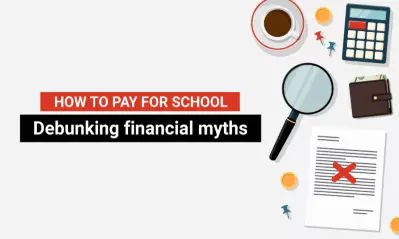I have to work. Am I still eligible for financial aid?

Written by Michael Feder

Reviewed by Chris Conway, Director of Financial Education Initiatives and Repayment Management

During the 2020-21 application cycle , the U.S. Department of Education received more than 17 million Free Application for Federal Student Aid (FAFSA®) forms. Each application represents a student or family trying to see how much federal assistance they might receive to pursue educational goals.
Among several other criteria, income plays a major role in determining the financial aid a student qualifies for.
Understandably, this makes some adult student applicants concerned that their employment income might exclude them from receiving federal financial aid. Could someone have too high of an income to qualify for more financial aid?
How is federal financial aid eligibility determined?
When a student or family applies for financial aid, determining eligibility is a multi-factor process. More than just income is at play. Other factors that affect eligibility include:
- The size of the family
- Full-time or part-time student status
- Dependency status
- Citizenship status
- Academic progress
Determining financial need
Two main factors ultimately determine a student’s eligibility and how much financial aid they receive. These are:
- Cost of attendance (COA)
- Student Aid Index (SAI), which was formerly the Expected Family Contribution (EFC)
COA is basically what it sounds like: the expenses a student takes on by attending school. This isn’t the same thing as tuition, however. COA comprises tuition and fees, books and supplies, living expenses (including housing and food), dependent-care related expenses, transportation and more.
COAs are generally set averages provided by schools that may vary based upon the student’s credential level, program, enrollment status or living arrangements.
SAI is an eligibility index number that a school’s financial aid office uses to determine how much federal student aid a student would receive. This number results from the information provided on the FAFSA. This number is not a dollar amount of aid eligibility or what a family is expected to provide. A negative SAI indicates the student has a higher financial need.
Financial need is calculated as follows:
Financial need = COA – SAI
When a student has calculated their financial need, they can explore different programs to see what kind of funding (if any) their financial need makes them eligible for. Keep in mind, there are various eligibility criteria that must be met in addition to a student’s financial need.
Here’s where it gets tricky: Looking at this equation, it would be easy for a student to conclude that reducing their income can increase their financial need, and therefore qualify them for larger sums of federal aid. But this line of thinking is actually incorrect — and the reason boils down to how exactly the SAI is calculated.
Do all financial aid programs take income into account?
Federal financial aid programs that use income to determine eligibility are collectively called need-based aid. These include:
- Federal Pell Grant
- Federal Supplemental Educational Opportunity Grant (FSEOG)
- Direct Subsidized Loan
Each of these programs has specific eligibility requirements and limits on how much a student can receive.
There are other nuances too. Loans have to be repaid while grants do not (except under certain circumstances ). And not all financial aid programs necessarily take a student’s or family’s income into account when eligibility is being determined. There is an entire category of federal financial aid programs that do not take income into account at all. This category is considered non-need-based federal student aid, and it includes:
The amount a student is eligible for through these programs is determined by subtracting the financial aid awarded to the student from their cost of attendance.
I have a job. Am I still eligible for financial aid?
It’s hard to give a one-size-fits-all answer to this question. To determine eligibility, students should complete the FAFSA form.
Christine Conway, the director of Financial Education Initiatives at University of Phoenix, underscores the importance of keeping an open mind about options.
“Look into all options to pay before borrowing,” she advises. “Find out if your employer offers education assistance. If so, find out how the program works.”
Conway emphasizes knowing the total cost of the program you’re considering, and creating a financial plan to pay for the total cost. The surest way to find out if you’re eligible for financial aid is to submit a FAFSA form .
After exploring options to receive aid and tuition reimbursement, Conway says it’s time to turn it all into a solid financial plan.
“If your financial plan includes loans,” Conway says, “understand your rights and responsibilities. Loans have to be repaid. Make sure you know what the future monthly payment will be once you’re in repayment.”
Save time and money with a degree from University of Phoenix
It’s important to know your options before deciding on your educational future. University of Phoenix (UOPX), for example, accepts certain types of financial aid .
The University also makes it easy to see where students can save on their education. Using the Savings Explorer® tool , degree seekers can find opportunities to save by leveraging their previous college, life and work experience.
Students also pay one flat, affordable tuition rate at UOPX, from the moment they enroll to the day they graduate from their program. This fixed Tuition Guarantee offers transparency so that students know exactly what their education will cost, no matter what life throws their way.
Limits, after all, are a good thing when it comes to tuition and even financial aid. But your education should know no bounds.

ABOUT THE AUTHOR
A graduate of Johns Hopkins University and its Writing Seminars program and winner of the Stephen A. Dixon Literary Prize, Michael Feder brings an eye for detail and a passion for research to every article he writes. His academic and professional background includes experience in marketing, content development, script writing and SEO. Today, he works as a multimedia specialist at University of Phoenix where he covers a variety of topics ranging from healthcare to IT.

ABOUT THE REVIEWER
As Director of Financial Education Initiatives and Repayment Management, Chris Conway works with departments across the University to provide resources that allow students to make more informed financial decisions. She is also an adjunct faculty member for the Everyday Finance and Economics course at the University, and she chairs the National Council of Higher Education Resources College Access and Success Committee. Conway is committed to helping college students make the right financial decisions that prevent future collection activity.
This article has been vetted by University of Phoenix's editorial advisory committee.
Read more about our editorial process.
Read more articles like this:


